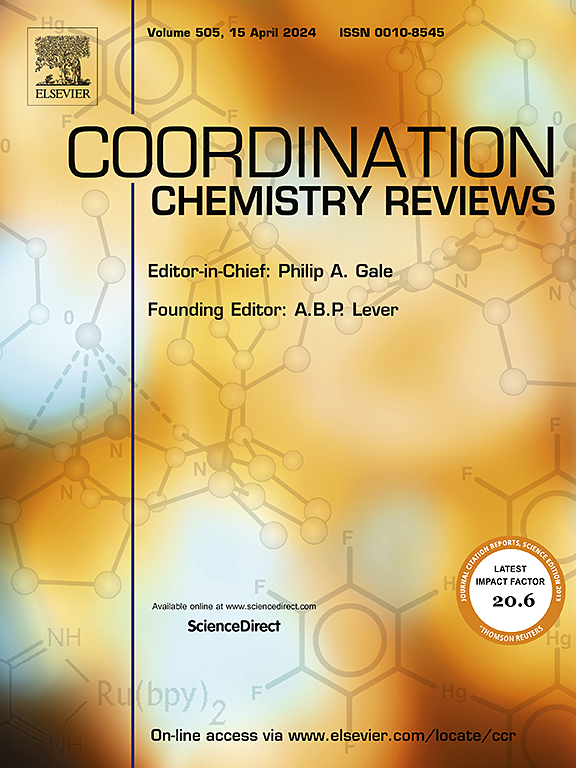用于耐腐蚀的多功能二维材料:石墨烯,MXenes和下一代新兴纳米结构
IF 23.5
1区 化学
Q1 CHEMISTRY, INORGANIC & NUCLEAR
引用次数: 0
摘要
腐蚀仍然是各行业面临的重大挑战,导致结构退化、经济损失和安全问题。这篇综述探讨了配位化学和二维层状材料的概念,特别是石墨烯,在增强耐腐蚀性方面,并深入研究了下一代新兴纳米结构,如过渡金属二硫族化合物(TMDs)、MXenes、六方氮化硼(h-BN)和金属有机框架(mof)。本文综述了该技术的缓蚀机理、可扩展性、环境影响和工业可行性。该综述表明,虽然石墨烯具有优异的阻隔性能,但其长期性能受到缺陷引起的局部腐蚀的阻碍。tmd具有优异的化学稳定性和钝化效果,而MXenes具有高导电性和自愈能力,使其成为活性腐蚀防护的有希望的候选者。同时,h-BN具有优异的耐热性和耐化学性,mof通过控制释放机制引入了一种新的缓蚀方法。然而,氧化敏感性、生产可扩展性和长期稳定性仍然是工业应用的关键障碍。这些发现强调了进一步研究杂化材料系统、功能化策略和环保合成方法的必要性,以优化二维材料的缓蚀效果。通过提供比较评价,本综述有助于了解下一代可持续腐蚀防护技术,并指导未来工业腐蚀控制材料的创新。本文章由计算机程序翻译,如有差异,请以英文原文为准。

Multifunctional 2D materials for corrosion resistance: Graphene, MXenes and next generation emerging nanostructures
Corrosion remains a significant challenge across various industries, leading to structural degradation, financial losses, and safety concerns. This review explores the coordination chemistry and the concepts of 2D layered materials, particularly graphene, in enhancing corrosion resistance and delves into next-generation emerging nanostructures such as transition metal dichalcogenides (TMDs), MXenes, hexagonal boron nitride (h-BN), and metal-organic frameworks (MOFs). The present review is focused on the corrosion inhibition mechanisms, scalability, environmental impact, and industrial feasibility. The review unveils that while graphene exhibits exceptional barrier properties, its long-term performance is hindered by defect-induced localized corrosion. TMDs demonstrate superior chemical stability and passivation effects, whereas MXenes provide high electrical conductivity and self-healing capabilities, making them promising candidates for active corrosion protection. Meanwhile, h-BN offers excellent thermal and chemical resistance, and MOFs introduce a novel approach to corrosion inhibition through controlled release mechanisms. However, oxidation susceptibility, production scalability, and long-term stability remain critical obstacles for industrial implementation. These findings highlight the need for further research into hybrid material systems, functionalization strategies, and eco-friendly synthesis methods to optimize the effectiveness of 2D materials in corrosion mitigation. By providing a comparative evaluation, this review contributes to the growing knowledge on the next-generation sustainable corrosion protection technologies and guides future material innovations in industrial corrosion control.
求助全文
通过发布文献求助,成功后即可免费获取论文全文。
去求助
来源期刊

Coordination Chemistry Reviews
化学-无机化学与核化学
CiteScore
34.30
自引率
5.30%
发文量
457
审稿时长
54 days
期刊介绍:
Coordination Chemistry Reviews offers rapid publication of review articles on current and significant topics in coordination chemistry, encompassing organometallic, supramolecular, theoretical, and bioinorganic chemistry. It also covers catalysis, materials chemistry, and metal-organic frameworks from a coordination chemistry perspective. Reviews summarize recent developments or discuss specific techniques, welcoming contributions from both established and emerging researchers.
The journal releases special issues on timely subjects, including those featuring contributions from specific regions or conferences. Occasional full-length book articles are also featured. Additionally, special volumes cover annual reviews of main group chemistry, transition metal group chemistry, and organometallic chemistry. These comprehensive reviews are vital resources for those engaged in coordination chemistry, further establishing Coordination Chemistry Reviews as a hub for insightful surveys in inorganic and physical inorganic chemistry.
 求助内容:
求助内容: 应助结果提醒方式:
应助结果提醒方式:


